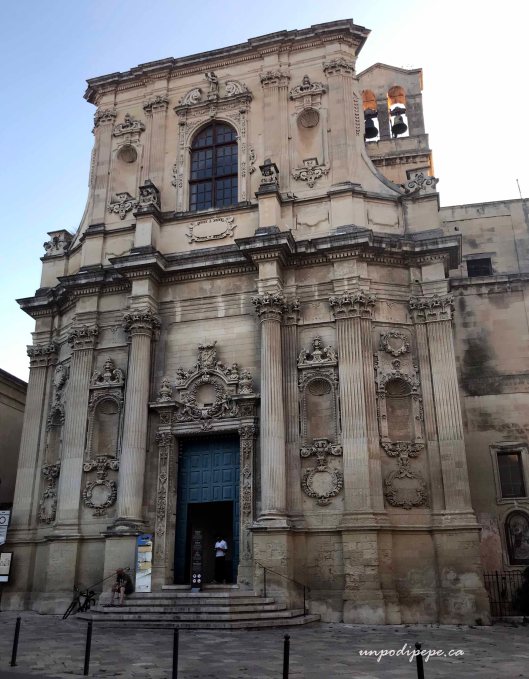 La Serenissima turns 1603 today! Venezia, a geographically unique engineering marvel, is built on a group of 118 tiny islands in the Venetian lagoon. They are separated by open water and 170 canals, linked by over 400 footbridges. Named after the ancient Veneti people of the 10th Century BC, Venezia was founded March 25, 421 by refugees from the Roman cities of Padua, Aquilea and Treviso, and the surrounding countryside fleeing Longobard and Hun invasions. They first settled on the sandy islands of Torcello and Jesolo. The land of the islands in the lagoon was muddy, some of it barely above water, and not suitable to build on. Millions of wooden poles or pilings were submerged into the mud and sand to reach the solid layer of earth underneath. The pilings were covered with wooden boards to form the base that the city was built on. Since there was no forest in the area, the wood came from Croatia, Slovenia and Montenegro.
La Serenissima turns 1603 today! Venezia, a geographically unique engineering marvel, is built on a group of 118 tiny islands in the Venetian lagoon. They are separated by open water and 170 canals, linked by over 400 footbridges. Named after the ancient Veneti people of the 10th Century BC, Venezia was founded March 25, 421 by refugees from the Roman cities of Padua, Aquilea and Treviso, and the surrounding countryside fleeing Longobard and Hun invasions. They first settled on the sandy islands of Torcello and Jesolo. The land of the islands in the lagoon was muddy, some of it barely above water, and not suitable to build on. Millions of wooden poles or pilings were submerged into the mud and sand to reach the solid layer of earth underneath. The pilings were covered with wooden boards to form the base that the city was built on. Since there was no forest in the area, the wood came from Croatia, Slovenia and Montenegro.
Venezia was the capital of the Venetian Republic for almost a century, from 810 until 1797 when it was defeated by Napoleon. In 1866, along with the rest of the Veneto region, it became part of the Kingdom of Italy. The title ‘La Serenissima’ refers to its stability as a government compared to others at the time. Venezia was a wealthy city for most of its history, especially the 13th-17th centuries. It was as an influential financial and maritime power and important center of art, commerce, and trade of silk, grain and spices between East and West. This east/west connection is apparent in the art and architecture of the city. The Venetian Lagoon and historical parts of the city within the lagoon became a UNESCO World Heritage Site in 1987. The population of Venezia is now about 55,000 and the PATREVE (Padua, Treviso, Venezia) metro area has a population of 2.6 million.
 I have been to Venezia 5 times and my most recent visit was following an unintentional 28 year absence! I still remember stepping out of Stazione Santa Lucia the first time, and immediately being filled with wonder and awe at the view. That part hasn’t changed a bit since 1980. This time I was there for 3 days in early October but the weather was like summer. So were the crowds! It was unbelievable how many people were in the streets and waiting in lines! Someone forgot to tell everyone it was not July! I also noted much more expensive it was than the rest of Italia. When I saw the lineups for everything in Piazza San Marco-even for those with reservations, I decided to concentrate on exploring outside. I enjoyed the beautiful weather and only visited a few places that were new to me. I definitely want to see the incredible interior of Basilica San Marco and the 4 Cavalli again, but will wait for a rainy day!
I have been to Venezia 5 times and my most recent visit was following an unintentional 28 year absence! I still remember stepping out of Stazione Santa Lucia the first time, and immediately being filled with wonder and awe at the view. That part hasn’t changed a bit since 1980. This time I was there for 3 days in early October but the weather was like summer. So were the crowds! It was unbelievable how many people were in the streets and waiting in lines! Someone forgot to tell everyone it was not July! I also noted much more expensive it was than the rest of Italia. When I saw the lineups for everything in Piazza San Marco-even for those with reservations, I decided to concentrate on exploring outside. I enjoyed the beautiful weather and only visited a few places that were new to me. I definitely want to see the incredible interior of Basilica San Marco and the 4 Cavalli again, but will wait for a rainy day!

Signore in piazza, Cannareggio
Venezia is shaped like a fish and there are 6 sestieri or neighbourhoods:
- Santa Croce the west end ‘mouth’ of the fish is the transportation hub, with the bus and train stations, harbour of San Basilio, and parking garage in Piazzale Roma.
- San Marco is the touristy center with Piazza San Marco and Rialto
- Dorsoduro is the trendy Southeastern area across Canal Grande and includes Giudecca, Piazza and Ponte Accademia, Collezione Peggy Guggenheim and Santa Maria della Salute
- San Polo across the Ponte Rialto, is the oldest sestiere and includes Rialto fruit and fish mercato
- Cannareggio the most northern area is less crowded and touristy, more of the ‘real’ Venezia. It includes the Jewish quarter. It is picturesque and the best place to get lost among the calli (streets)
- Castello the eastern ‘tail’ of the fish and largest sestiere is host to the Biennale in the Arsenale Naval base

Calcio in Castello
Main things to see and do: Wander aimlessly, get lost and explore! Venezia is a photographer’s paradise, a walkable city and many of the sights are clustered. Walk from Piazzale Roma to Piazza San Marco (40 min-1 hour), explore the ponti (bridges) and narrow calle (streets) look for cisterne (rainwater collection wells), walk along Riva degli Schiavoni to see the gondole bobbing up and down in the water and stop for cicchetti (Venetian snacks).
Wander aimlessly, get lost and explore! Venezia is a photographer’s paradise, a walkable city and many of the sights are clustered. Walk from Piazzale Roma to Piazza San Marco (40 min-1 hour), explore the ponti (bridges) and narrow calle (streets) look for cisterne (rainwater collection wells), walk along Riva degli Schiavoni to see the gondole bobbing up and down in the water and stop for cicchetti (Venetian snacks).
Cruise Canal Grande. Buy a Vaporetto pass and explore the Canal Grande from the water. Get on in front of Stazione Santa Lucia and cruise to San Marco or vice versa. Canal Grande is S shaped and lined with ~170 majestic palazzi, buildings from the 13-18th Many of them are fondaco houses, meaning the ground floor was a warehouse and merchants lived on the upper floors with their families. 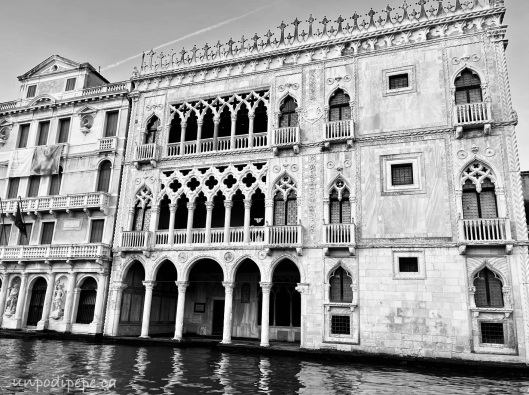 3 of my favourite palazzi are the Fondaco dei Turchi, the Venetian Gothic Ca’ d’Oro, and Palazzo Dario, which is funky because it started out Gothic but was renovated in Renaissance style. I love to spot interesting boats… the ambulance boat, the dry-cleaning delivery boat, etc.
3 of my favourite palazzi are the Fondaco dei Turchi, the Venetian Gothic Ca’ d’Oro, and Palazzo Dario, which is funky because it started out Gothic but was renovated in Renaissance style. I love to spot interesting boats… the ambulance boat, the dry-cleaning delivery boat, etc.
Piazza San Marco is the main piazza in Venezia and is full of things to see. The multi domed Basilica is at the east end, and the rest is lined with arcades. These were once homes and offices, now shops and restaurants. In the piazza is a 4.5m bronze winged lion, the symbol of San Marco and the Venetian Republic. It is on top of Egyptian granite column brought here in the 12th Napoleon moved it to Paris but it was returned in 1815. Torre dell’Orologio, the clocktower dates back to the 15th Century.
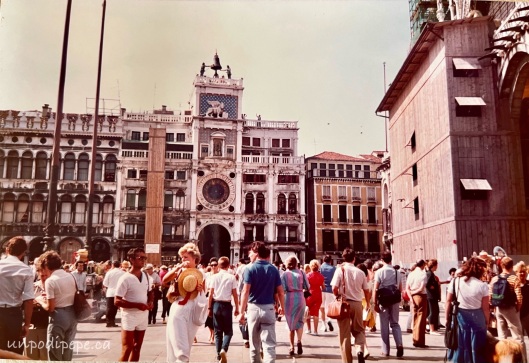
Torre dell’Orologio 1980
Visit Basilica San Marco, built in the 9th century and enlarged in 1063. Over 8 centuries, golden mosaics and other treasures were added. The exterior is magnificent, with a combination of Byzantine, Romanesque and Gothic features.  The Western side has mosaic archways while the Southern side has gothic adornments. The Interior has 8000 m² of golden mosaics. Gold leaf is sandwiched between 2 layers of glass tile, giving an illumination effect. The evening tour is apparently spectacular as it is lit up. The Cavalli di San Marco, 4 magnificent ancient Greek bronze horses were brought from Constantinople in 1204. Since 1974, replicas are on the terrace above the entrance, and the originals are inside. They need their own blog post! Admission €3 onsite, €6 online in advance. Extra €5 to see Pala d’oro altar piece and Cavalli. Open 0930—1715, 1400-1715 Sundays. Note….even if booked online, you still have to arrive early and wait in lineups for security.
The Western side has mosaic archways while the Southern side has gothic adornments. The Interior has 8000 m² of golden mosaics. Gold leaf is sandwiched between 2 layers of glass tile, giving an illumination effect. The evening tour is apparently spectacular as it is lit up. The Cavalli di San Marco, 4 magnificent ancient Greek bronze horses were brought from Constantinople in 1204. Since 1974, replicas are on the terrace above the entrance, and the originals are inside. They need their own blog post! Admission €3 onsite, €6 online in advance. Extra €5 to see Pala d’oro altar piece and Cavalli. Open 0930—1715, 1400-1715 Sundays. Note….even if booked online, you still have to arrive early and wait in lineups for security.
Palazzo Ducale-Venetian Gothic style former residence of the Doges and Palazzo di Giustizia (courthouse) next to Basilica San Marco. It is now a museum. Cross Ponte dei Sospiri (bridge of sighs) to see prisoners’ last view on their way to execution. Admission €25 Open 0900-1800 daily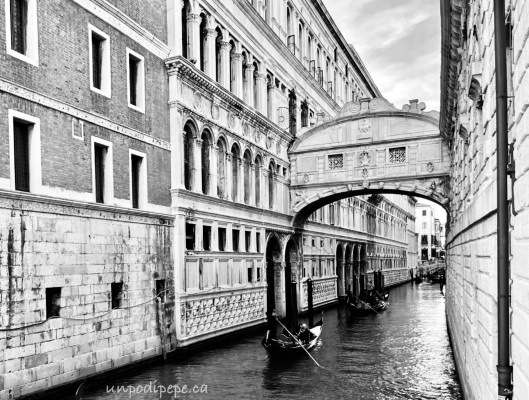
Climb Campanile-Take the elevator to the top of the belltower for amazing views. Reservations are booked for a specific time slot €10 Euro, €12 online. May be closed during maltempo-bad weather.
Collezione Peggy Guggenheim Former home of the heiress, now a museum of modern art in the Dorsoduro area. Take a €2 traghetto gondola ride across Canal Grande from San Marco or walk across Ponte dell’ Accademia. Admission €16 open 1000-1800 Closed Tuesdays. Read my post here.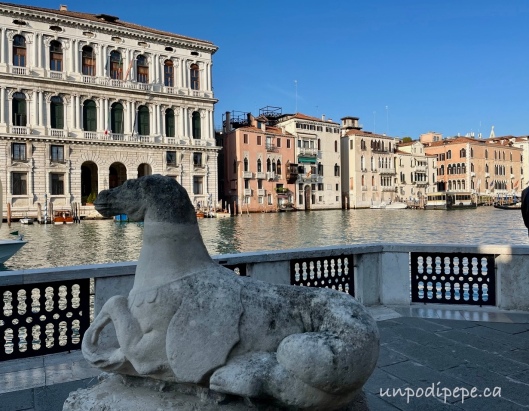 Santa Maria della Salute the Baroque church at the entrance to Canal Grande next to Punta della Dogana, has been immortalized by artists Canaletto, Sargent, Turner and Monet. The octagonal church made of Istrian stone has 2 domes and 2 bell towers in the back. Built in 1687 to celebrate the end of the plague (black death) that killed 1/3 of the population. Santa Maria della Salute means ‘Our Lady of Good Health’.
Santa Maria della Salute the Baroque church at the entrance to Canal Grande next to Punta della Dogana, has been immortalized by artists Canaletto, Sargent, Turner and Monet. The octagonal church made of Istrian stone has 2 domes and 2 bell towers in the back. Built in 1687 to celebrate the end of the plague (black death) that killed 1/3 of the population. Santa Maria della Salute means ‘Our Lady of Good Health’.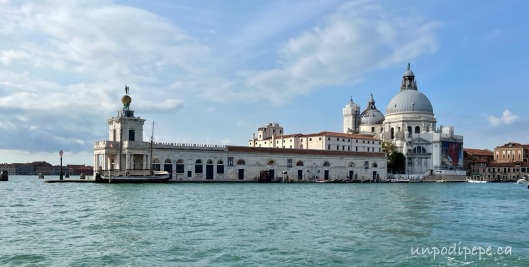
Entrance to the Basilica is free, climb steps to the cupola €4 Open 0900-1200 and 1500-1730. Cupola closed Mondays. Take the ‘ferry gondola’ across from Piazza San Marco for €2. Nov 21 is the Festa della Salute featuring a parade from San Marco to La Salute over a pontoon bridge.
Ponte dell’ Accademia walk over the old wooden bridge for the best views of Canal Grande
Ponte Rialto a covered footbridge lined with shops has great views from both sides. It is the oldest of 4 bridges that span the Canal Grande. The original was built in 1173 and it was rebuilt several times. The present bridge was built in 1591.

Gondola ride Ponte Rialto 1995
Ride in a gondola Gondolas are unique, symbolic of Venezia and have been a means of transport on waterways here for over 10 Centuries, so you really do need to do this! Gondola rides are usually €80 for a 30-40 minute ride and €100 in the evening.  If this is not in your budget, or you are travelling solo like me, there are inexpensive traghetti, or gondola ferries you can take with others to cross to the other side of Canal Grande for € Best deal in town! Look for the green ‘traghetti’ sign. There is now a special dock at Piazzale Roma for those with mobility issues to safely get into a gondola.
If this is not in your budget, or you are travelling solo like me, there are inexpensive traghetti, or gondola ferries you can take with others to cross to the other side of Canal Grande for € Best deal in town! Look for the green ‘traghetti’ sign. There is now a special dock at Piazzale Roma for those with mobility issues to safely get into a gondola. Scala Contarini del Bovolo Cool external 26 m multi arch spiral staircase near Piazza San Marco. It was added to the palazzo in 1499. View of rooftops, the Campanile, the cupole of San Marco and La Salute. €8 admission Open 1000-1800 daily.
Scala Contarini del Bovolo Cool external 26 m multi arch spiral staircase near Piazza San Marco. It was added to the palazzo in 1499. View of rooftops, the Campanile, the cupole of San Marco and La Salute. €8 admission Open 1000-1800 daily.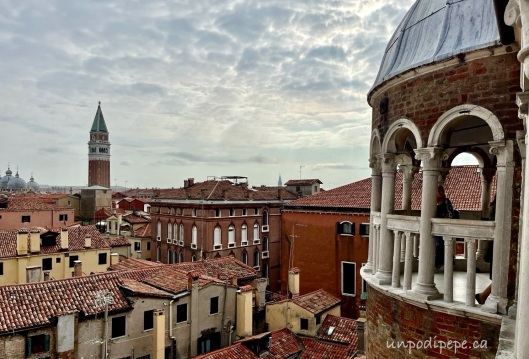
La Fenice The opera house was well named! Like the Phoenix it has risen from the ashes after being destroyed by fire 3 times, most recently in 1996. It was reopened in 2003. Admission €12 including audioguide tour. Open 0900-1800
Visit the islands Take the vaporetto to Murano, Burano, Torcello, Lido and San Giorgio Maggiore.
Terrazza Fondaco dei Tedeschi (T Fondaco). Tedeschi are Germans. This was the German merchants’ warehouse, then the post office, now a luxury department store. It is at the foot of Ponte Rialto, northwest end. The rooftop terrace has panoramic views over Canal Grande. Open daily 1015-1800. Entrance is free, reservations are required and the timeslot is only 15 minutes. Reservations must be made on their website.
Feste: Venezia has feste all year round, most of them involve gondola races!
- January 6th Regatta delle Befane-50 rowing club members dress up as La Befana and race from San Tomà to Ponte Rialto, where the finish line is a giant stocking hanging from the bridge!
- February-Carnevale the 10 days before Ash Wednesday (22 Feb -4 Mar in 2025).
- March 25th anniversary of Venezia and festa of the Annunciation
- Biennale d’Arte held even years. 20 April-24 Nov, 2024
- April 25 Festa di San Marco, patron Saint of Venezia
- May-1st since the 11th Century, the Sunday after Ascension Day is Sensa, the marriage of Venezia with the sea
- May-Vogalonga, a non-competitive 30Km rowing celebration between canals and the islands. A peaceful protest against damage due to waves from motorboats.
- July-the 3rd Sunday Redentore Fireworks July 20-21, 2024
- Late August/early Sept Venice Film Festival on Lido di Venezia Aug 28-Sept7, 2024
- September, 1st Sunday Regatta Storica
- October Venice Marathon Oct 24, 2004 38th annual
- November 21 Salute Celebration. Feast of Santa Maria della Salute celebrating the end of the devastating Black plague that killed 1/3 of population
- December 7th-lighting of tree in Piazzetta San Marco
- December-Mercatino di Natale in Dorsoduro
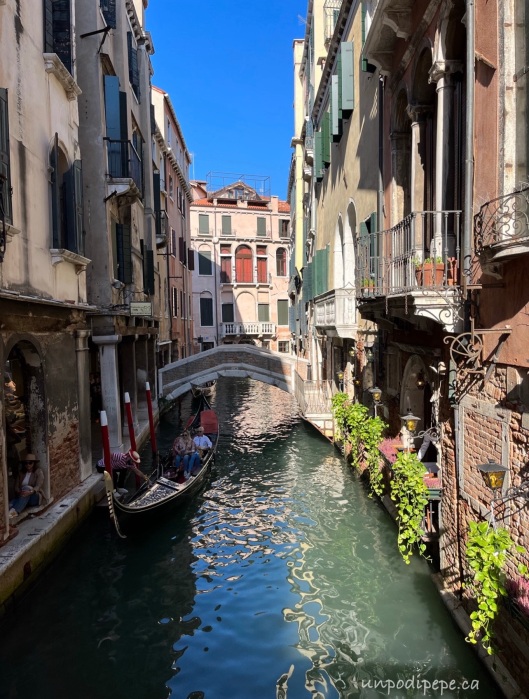 Getting there and around:The main airport Marco Polo is 10 km away. Ryanair and some other budget airlines use Treviso airport 40 km away. An airport express bus takes you to Piazzale Roma in half an hour for €10. Then walk or take vaporetto to hotel. Alilaguna waterbus is €15 and has several stops. Shared watertaxi is €35 per person with several stops along the 1 hour route. Private watertaxi is much more expensive.
Getting there and around:The main airport Marco Polo is 10 km away. Ryanair and some other budget airlines use Treviso airport 40 km away. An airport express bus takes you to Piazzale Roma in half an hour for €10. Then walk or take vaporetto to hotel. Alilaguna waterbus is €15 and has several stops. Shared watertaxi is €35 per person with several stops along the 1 hour route. Private watertaxi is much more expensive.
Train-Stazione Santa Lucia in Santa Croce area. Walk or take vaporetto to hotel. Car parking garage ‘Tronchetto parking’ in Piazzale Roma has a capacity of 4500 cars
Actv Vaporetto is a waterbus and an affordable way to sightsee. Also used by residents to get around and get to work. Single ticket one way €9.50, daypass €25. Passes for 2, 3 and 7 days are also available. It is not necessary to buy these in advance. With my daypass, I cruised to San Marco, then took another vaporetto at San Zaccaria (in front of Hotel Danieli) to Burano and Torcello.
Venezia is a one of the most visited destinations in the world, with over 20 million tourists per year. It is crowded, more expensive than anywhere else in Italia, and struggling with the effects of overtourism. Acqua Alta, high water flooding happens in late autumn to early spring. Usually predictable and lasts only a few hours. Read my post on MOSE.

Cannareggio
I have talked about the crowds, the lines, the expense….but do not let that put you off. There is nowhere else like Venezia with its intricate maze of waterways, art, and unique architecture. Around every corner is another magical scene. The entire city is an extraordinary masterpiece, so I definitely recommend visiting. It can be compared to Santorini, which is crowded and expensive, but incredibly unique and historically rich. My recommendation is to stay 3-4 days. In 2022, only 3.2 million visitors out of 30 million stayed overnight.
As of June 1, 2024, in an effort to decrease the effects of mass tourism, regulate huge crowds and improve life for local residents, Venezia will be trialing a €5 entry charge. Residents, commuters, students and children under 14 will be exempt, as well as anyone who has booked an overnight stay. Personally, I think the entry fee is too low to be effective. Constant maintenance to prevent more water damage is expensive. Tour groups will also be limited to 25 people (=½ the capacity of a bus) and loudspeakers are banned(yeah!!!). Cruise ships have been banned from the lagoon since 2021 after threats from UNESCO to put it on the endangered list. That is the UNESCO equivalent to ‘the naughty list’!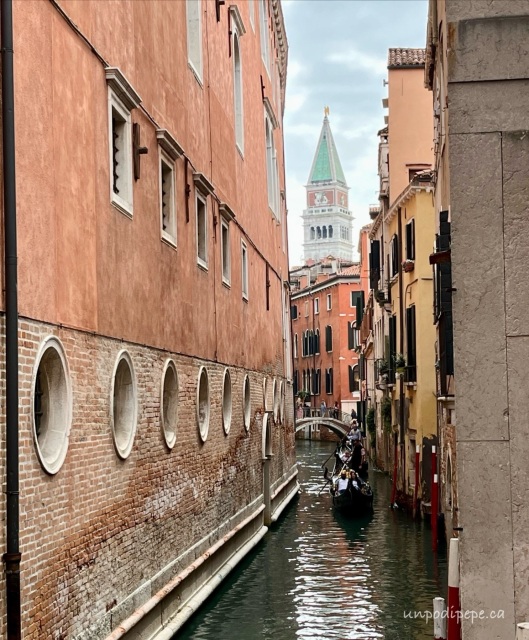
Hope you all make it to Venezia at some point! Buon viaggio, Cristina
**Photo credits: 1995 Lucia and Donato on honeymoon taken by unknown gondolier. All other photos by me!
 Burano, an island in the north end of the Venetian lagoon, is one of the most colourful places in the world. It is known for merletto (lace) and houses painted in bright contrasting colours. Burano is only 210 m² with a population of 2,800. That is a lot of people for such a tiny place- 13,000 per km². Burano is actually made up of 4 islands separated by 3 canals and connected by bridges. The highest elevation is only 1m! There are no cars-not even for residents, since there are no roads! Burano is part of the city of Venezia, 7 km away.
Burano, an island in the north end of the Venetian lagoon, is one of the most colourful places in the world. It is known for merletto (lace) and houses painted in bright contrasting colours. Burano is only 210 m² with a population of 2,800. That is a lot of people for such a tiny place- 13,000 per km². Burano is actually made up of 4 islands separated by 3 canals and connected by bridges. The highest elevation is only 1m! There are no cars-not even for residents, since there are no roads! Burano is part of the city of Venezia, 7 km away. 

 An official government request must be sent in to paint a home on Burano as there is a system to the colour scheme. The response lists the colours allowed for that particular site! No 2 houses side by side can be the same colour.
An official government request must be sent in to paint a home on Burano as there is a system to the colour scheme. The response lists the colours allowed for that particular site! No 2 houses side by side can be the same colour.
 Burano is a photographer’s dream with the rainbow houses, laundry hanging, fishing boats, canals and narrow streets. It is hard to take a bad shot! The wooden Tre Ponti bridge is a great selfie spot.
Burano is a photographer’s dream with the rainbow houses, laundry hanging, fishing boats, canals and narrow streets. It is hard to take a bad shot! The wooden Tre Ponti bridge is a great selfie spot. 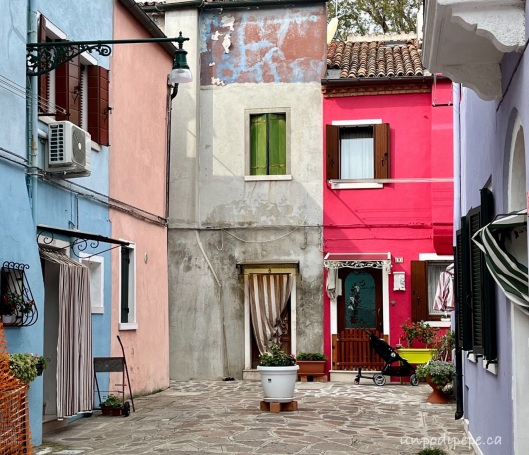 My usual advice would be to just wander and get lost, but Burano is too small to even get lost on! A quick walk around the island only takes about half an hour.
My usual advice would be to just wander and get lost, but Burano is too small to even get lost on! A quick walk around the island only takes about half an hour. Explore the quieter side streets, browse the shops and have lunch along one of the canals. Being a fishing island, the seafood is exceptional. Try take out fritto misto, assorted fried fish in a paper cone, or the family run Trattoria Al Gatto Nero. a reservation-even in October!
Explore the quieter side streets, browse the shops and have lunch along one of the canals. Being a fishing island, the seafood is exceptional. Try take out fritto misto, assorted fried fish in a paper cone, or the family run Trattoria Al Gatto Nero. a reservation-even in October!














































































































































